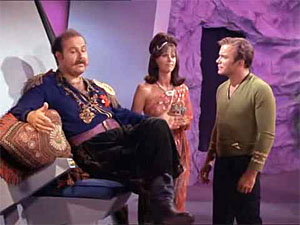 “I, Mudd” is a sequel to “Mudd’s Women“, starring the irritating con-man Harcourt Fenton “Harry” Mudd. Unfortunately, where the former was at least moderately tolerable and had the kernel of a decent story driving it, this episode is rather painful to watch.
“I, Mudd” is a sequel to “Mudd’s Women“, starring the irritating con-man Harcourt Fenton “Harry” Mudd. Unfortunately, where the former was at least moderately tolerable and had the kernel of a decent story driving it, this episode is rather painful to watch.
It starts promisingly enough, with the mysterious newly assigned crewman Norman running rampant through the Enterprise, disabling people with a single rather soft karate chop to the neck, and taking control of the ship from the auxiliary control room. This shows how ridiculously easy it is to override the bridge controls. Someone does 10 seconds of hacking on a poorly guarded terminal elsewhere on the ship, and suddenly the helm doesn’t respond to anything Sulu does. After another completely ineffectual display by the Enterprise security team, Kirk is about to leave the bridge to personally kick some ass, when Norman arrives and declares that the ship is under his control and he is taking it to a mysterious planet 4 days away. Norman says any attempt to regain control will result in the Enterprise being destroyed, which Spock confirms with a glance at his display. Norman then reveals himself to be an android(!) and switches himself off.
After the opening credits, however, things rapidly go downhill, as it’s shown that even after 4 days nobody has bothered to move Norman off the bridge, where he stands blocking access to the turbolifts. Norman switches back on and commands the bridge crew to beam down, where they meet Harry Mudd surrounded by a bevy of beautiful female robots. It turns out he escaped the prison he was left in at the end of “Mudd’s Women”, then did some of his usual tricks, this time explicitly involving the selling of patented technology without paying royalties. You’d think they could have come up with some slightly more glamorous crime, but perhaps it was more important to show that, even in the post-scarcity economy of Star Trek, patents and intellectual property are serious business. There’s even a joke about it: Mudd: You couldn’t sell false patents to your mother! Spock: I fail to see why I should induce my mother to purchase falsified patents.
In a Chekhov’s gun scene, we see Harry show off a robot duplicate of his nagging wife, which he had made by the androids just so he could tell it to shut up and it would do so. The bulk of the episode is then made up of the crew trying to figure out how to escape from Mudd’s custody, despite the thousands of androids who follow his commands but otherwise are willing to do anything to keep the crew happy. It turns out the androids have their own agenda, wanting to serve humanity and cater to their desires, and in order to do so, they will enslave humanity to prevent them from being unhappy.
In the end, Kirk resorts to the reliable logic bomb approach (that he has used against rogue robots twice before), confusing the androids by acting out some truly painful scenes with the crew putting on ridiculous mime and acting sequences. This locks up all the androids except Norman, who is then defeated simply by Kirk telling him that Mudd always lies, followed by Mudd saying, “I am lying.” Kirk manages to reprogram all the androids in a miracle of off-screen editing, and leaves Mudd behind on the planet. Mudd thinks this is okay, until it turns out that 500 copies of his nagging wife have been made, and this time they won’t listen when he tells them to shut up.
Not as bad as “Catspaw”, but entirely uninspiring stuff, and rehashing themes we’ve seen explored in better ways already. Okay, I’m ready for some good episodes again.
Tropes: Robotic Reveal, Robot Girl, Cardboard Prison, Sidetracked By The Analogy, Chekhov’s Gun, Henpecked Husband, Gilded Cage, Zeroth Law Rebellion, Utopia Justifies The Means, Logic Bomb, Fate Worse Than Death, Hoist By His own Petard, Full Name Ultimatum.
Body count: None!

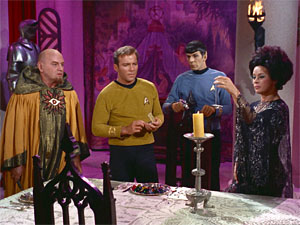 “
“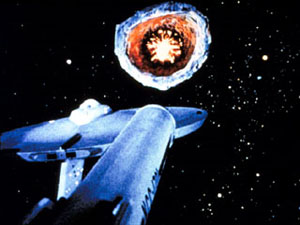 “
“

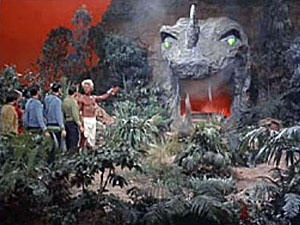 “
“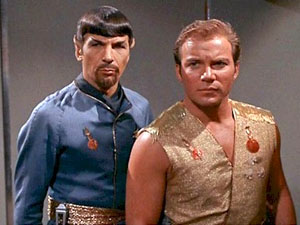 “
“
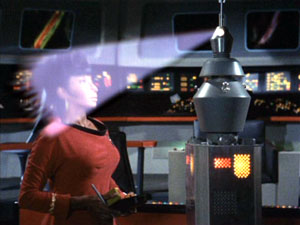 “
“